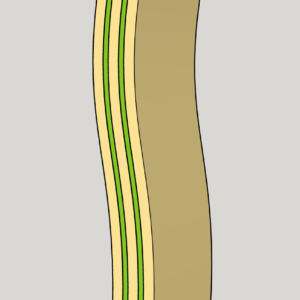HELP! Acrylic Plexiglass and Soft Maple – Bent Lamination Glue Up
I have an order for 100 beer tap handles that are to be made from a “sandwich” of soft maple and cast acrylic plexiglass (5 layers – maple, acrylic, maple, acrylic, maple). The handles will measure 2.25″ wide x 9″ tall – the maple will all be 3/16″ thickness and the acrylic is 1/8″ thickness. I have a clamping jig made from two CNC routed cauls that have matching curvature – an 1/8″ arc on either side of the center line from top to bottom (if each handle were marked at 4.5″, there is a curve above this center line and a curve below, bowing in opposite directions).
I have tested a “sandwich” using west systems 2 part epoxy, letting cure for 18 hours. Took it out of the clamping jig this morning and immediately, one of the outermost pieces of maple popped back to its original straight form. I was able to bang the handle on the bench top and release the tension in the remaining layers.
It seems to me that the thickness of each layer is not a problem – with no adhesive, the sandwich clamps together willingly with no audible cracking or tension related noises. As the bend does not seem to be an issue, I am left to believe that the adhesive I am using is the problem. I did notice there to be more of a visible film of cured epoxy left on the wood layers than the acrylic layers. Obviously a two part epoxy has no issue bonding to wood – should I try scuffing the epoxy before glue up or try another adhesive altogether?
Thanks for any help/suggestions! Picture of model below:
















Replies
Acrylic can be tough to glue. 2 part epoxy is one route, but not all epoxys are the same. I suggest contacting West to see which product they recommend.
Scuffing the plastic will help but may impact the final appearance.
A medium or thick CA glue is likely your best bet. Used without accelerator you should have enough time to clamp to shape before it sets up.
Be aware that wood and plastic move differently with temperature and humidity changes and that differential movement will stress your glue lines over time and may cause failures if the bond is poor, so keep running tests.
I'll second what Carbide said. Check with West Systems. I know that there are epoxies sold for plastic. I purchased some from Lowes a while back and it seems to have worked for my purposes but, what I used it for is stationary and not under any stress. So, I can't really vouch for how well it works.
Again, I second what Carbide said regarding different expansion rates. You didn't say why you needed to use a combination of wood and plastic but, if you can, I would substitute a layer of plastic the same color as maple. You can then use the adhesive designed for acrylic and be assured of a good bond and a lifetime of use. Or, go with two different species of wood and forego the acrylic.
I'd use maple dyed green, rather than the plastic. Solves a lot of issues.
You will find 2 components adhesives for acrylic if you search the 3M site. They come in dual syringes with a mixing nozzle. It is not epoxy and is used mostly in manufacturing of plastic goods. Read the data sheet carefully you will find adhesives that bond plastic and wood, acrylics (plexiglass) goes by the name Poly(methyl methacrylate).
https://www.3m.com/3M/en_US/company-us/all-3m-products/~/All-3M-Products/Adhesives-Tapes/Scotch-Weld/?N=5002385+8710676+8711017+8711736+3294857497&rt=r3
Some epoxies and plexiglas are sworn enemies. They can't be chemically bonded. I'm not going to argue with Carbide, but CA glues by melting the plastic. It will definitely affect the appearance.
Mikaol
This forum post is now archived. Commenting has been disabled